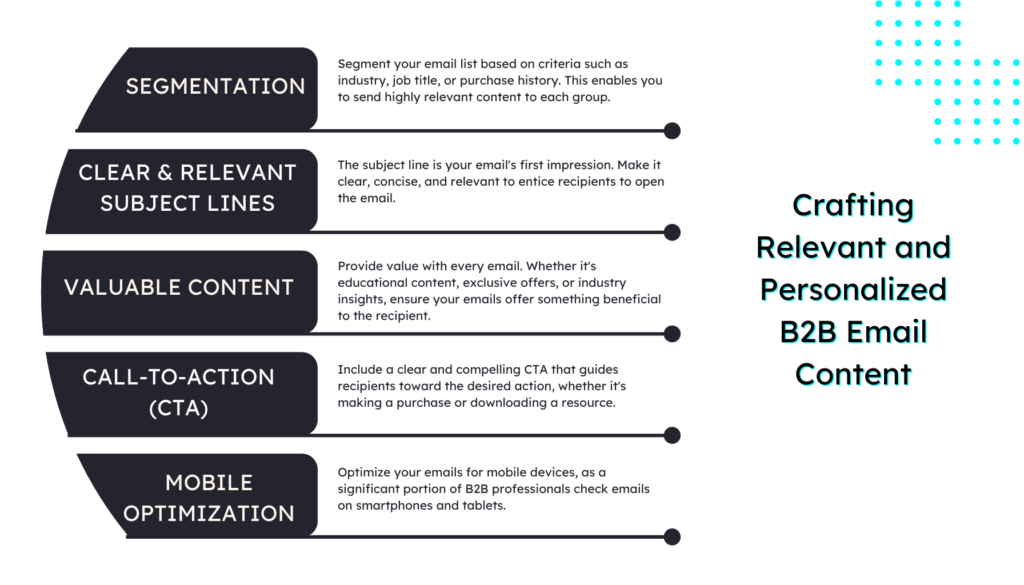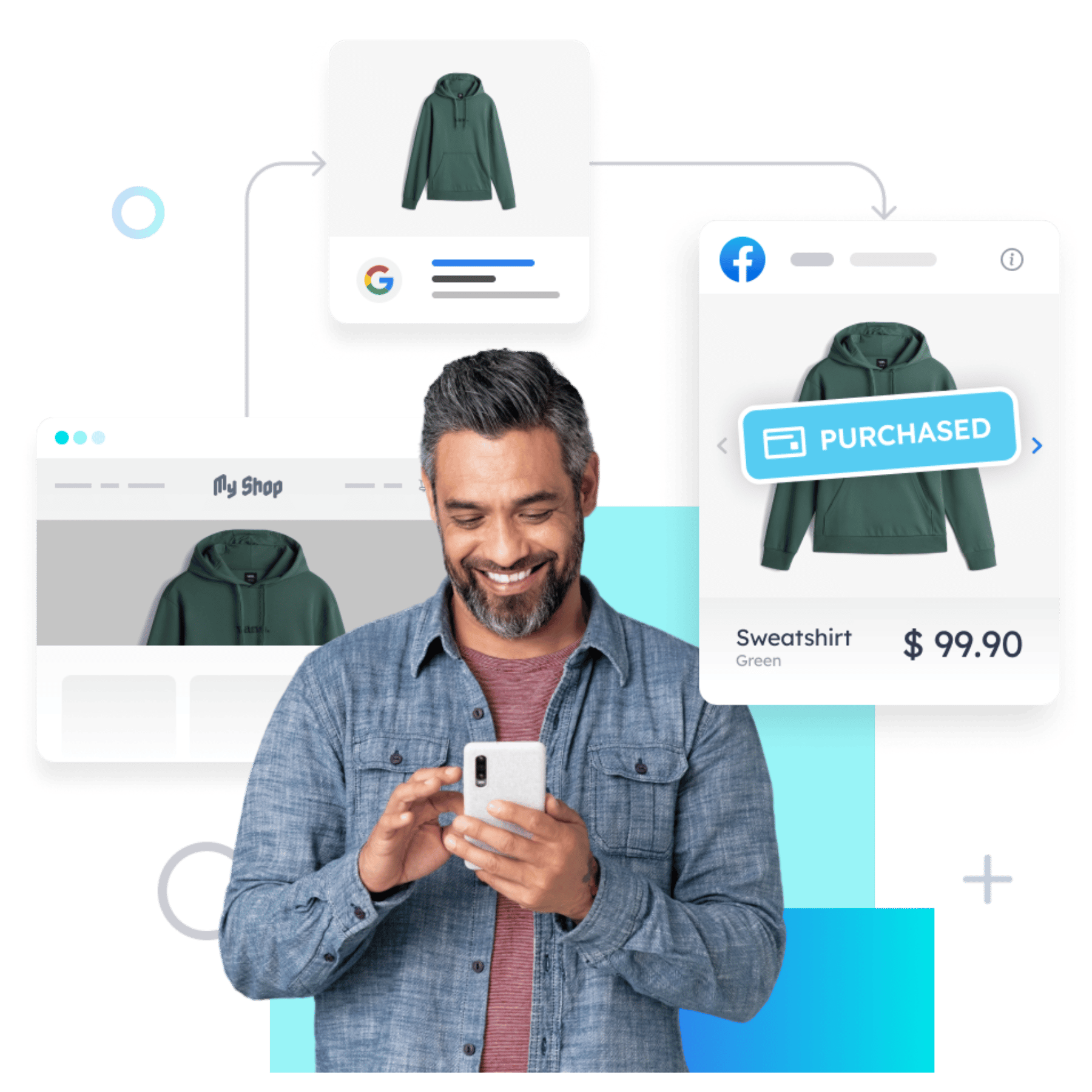
If you’re aiming to craft robust B2B eCommerce strategies capable of drawing in and converting your target customers, there are specific domains you must invest in. While traditional marketing approaches such as seeking referrals, participating in industry events, and cold outreach remain relevant, achieving substantial ROI for your business-to-business enterprise demands a focused investment in search engine optimization (SEO), pay-per-click advertising (PPC), and conversion rate optimization (CRO).
Navigating these intricate digital marketing practices can be daunting, especially if you’re unsure where to begin. In this post, we’re here to guide you through 10 online marketing strategies that hold immense potential for B2B eCommerce establishments.
Content Marketing Applied to B2B eCommerce
Content serves as the bridge between businesses and their customers, offering valuable insights, solutions, and information. This significance lies in its ability to:
- Educate and Inform: Content provides an avenue to educate your target audience about your industry, products, and services. It positions your brand as an authority, helping customers make informed decisions.
- Build Trust: High-quality content builds trust and credibility with potential customers. It demonstrates your expertise and commitment to solving their problems.
- Drive Traffic: Content, when optimized for search engines, can attract organic traffic to your website, increasing your online visibility and reach.
Strategy 1: Creating Valuable, Industry-Specific Content
Crafting content that resonates with your B2B eCommerce audience requires a strategic approach. Here are some tips to create content that adds value and relevance:
- Understand Your Audience and Talk to Them Personally: Begin by thoroughly understanding your target audience’s pain points, interests, and needs. Tailor your content to address these specific concerns. If you have clients in different industries you will need to dedicate time and effort to craft specific content, but the personal touch will end up paying off.
- Keyword Research: Conduct keyword research to identify the terms and phrases your audience is searching for. Incorporate these keywords naturally into your content to improve its search engine ranking.
- Diverse Content Formats: Experiment with various content formats such as blog posts, whitepapers, infographics, videos, and webinars. Different formats appeal to different learning styles and preferences.
- Consistency: Maintain a consistent content publishing schedule to keep your audience engaged. Regularly updated content also signals freshness to search engines.
- Quality Over Quantity: Focus on creating high-quality, well-researched content rather than churning out quantity. Quality content is more likely to be shared and referenced.
Strategy 2: Showcasing Successful Case Studies
One effective way to underscore the power of content marketing is by showcasing successful case studies. These real-world examples demonstrate how businesses have leveraged content to achieve their B2B eCommerce objectives. In these case studies, you can highlight:
- Challenges Faced: Explain the specific challenges or goals the business wanted to address through content marketing.
- Strategy Deployed: Describe the content marketing strategy adopted, including the types of content created and the platforms used for distribution.
- Results Achieved: Present tangible results, such as increased website traffic, lead generation, or revenue growth, to illustrate the impact of content marketing.
- Lessons Learned: Share valuable insights and lessons learned during the process that can benefit others in the B2B eCommerce space.
Search Engine Optimization (SEO) Applied to B2B eCommerce
Search Engine Optimization (SEO) is the cornerstone of any successful B2B eCommerce marketing strategy. Its significance lies in its ability to drive organic traffic to your website, thereby increasing your online visibility and attracting potential customers. Here’s why SEO plays a pivotal role:
- Enhanced Visibility: SEO techniques optimize your website’s ranking on search engine results pages (SERPs). When your website appears higher in search results, it is more likely to be discovered by users seeking relevant products or services.
- Cost-Effective: Compared to paid advertising, SEO offers a cost-effective means of acquiring organic traffic. While it requires an initial investment, the long-term benefits are substantial, as you don’t pay for clicks or impressions.
- Trust and Credibility: Websites that rank well in search results are often perceived as more trustworthy and credible by users. This trust can translate into higher conversion rates.

Strategy 3: Enhance On-Page and Off-Page SEO
A comprehensive SEO strategy encompasses both on-page and off-page techniques to optimize your website for search engines:
On-Page SEO: This involves optimizing the elements on your website itself. Key practices include:
- Keyword Optimization: Strategically placing relevant keywords in your content, meta titles, and descriptions.
- Quality Content: Creating valuable, informative, and engaging content that addresses user queries.
- User Experience (UX): Ensuring a user-friendly website design, fast loading times, and mobile optimization.
- Internal Linking: Connecting related pages within your website for better navigation and SEO.
Off-Page SEO: This focuses on activities outside your website that influence your search engine ranking. Key practices include:
- Link Building: Acquiring high-quality backlinks from reputable websites in your industry.
- Social Signals: Leveraging social media to promote your content and increase brand visibility.
- Online Reputation Management: Monitoring and managing online reviews and mentions to maintain a positive brand image.
Email Marketing Applied to B2B eCommerce
Email marketing remains a potent weapon in the arsenal of B2B eCommerce strategies. Its power lies in its ability to establish direct and personalized connections with your audience through their inboxes. Here’s why targeted email campaigns are a game-changer:
- Personalization: Targeted email campaigns allow you to personalize your messaging based on recipient preferences, behaviors, and demographics. This personal touch resonates with B2B customers, fostering a sense of importance.
- Lead Nurturing: Email serves as an effective tool for lead nurturing. By delivering relevant content at different stages of the buyer’s journey, you can guide prospects through the sales funnel.
- Conversion and Retention: Well-crafted emails can drive conversions by showcasing your products or services’ value propositions. Email is an excellent channel for nurturing customer relationships and encouraging repeat business.
Strategy 4: Crafting Relevant and Personalized B2B Email Content
Crafting compelling B2B email content is crucial for engagement and conversions. Here are some tips to ensure your emails resonate with your audience:
- Segmentation: Segment your email list based on criteria such as industry, job title, or purchase history. This enables you to send highly relevant content to each group.
- Clear and Relevant Subject Lines: The subject line is your email’s first impression. Make it clear, concise, and relevant to entice recipients to open the email.
- Valuable Content: Provide value with every email. Whether it’s educational content, exclusive offers, or industry insights, ensure your emails offer something beneficial to the recipient.
- Call-to-Action (CTA): Include a clear and compelling CTA that guides recipients toward the desired action, whether it’s making a purchase or downloading a resource.
- Mobile Optimization: Optimize your emails for mobile devices, as a significant portion of B2B professionals check emails on smartphones and tablets.

Social Media Marketing Applied to B2B eCommerce
While a strong presence on social media is essential, it’s equally crucial to tailor your strategies to the specific platforms where your B2B eCommerce audience resides.
Strategy 5: Leveraging Organic and Paid Social Reach Only Where Your Audience Is
- LinkedIn: As the leading professional networking platform, LinkedIn is ideal for B2B businesses. Share industry insights, thought leadership content, and connect with potential clients and partners.
- Twitter: Use Twitter to share real-time updates, engage in industry conversations, and participate in relevant hashtags and discussions.
- Facebook: While primarily a B2C platform, Facebook can be effective for B2B eCommerce when used to share engaging content, run targeted ads, and nurture customer relationships.
- Instagram: Visual content is compelling, even in the B2B space. Use Instagram to showcase your products, behind-the-scenes glimpses of your operations, and customer success stories.
- YouTube: Video content can be highly effective in B2B eCommerce. Create product demos, tutorials, and industry insights videos to engage and educate your audience.
Paid Advertising Applied to B2B eCommerce
Paid advertising in the B2B eCommerce realm encompasses various options, each with its unique benefits. Two prominent ones are Pay-Per-Click (PPC) advertising and display ads:
- Pay-Per-Click (PPC) Advertising: PPC ads, often seen on search engines like Google and Bing, allow you to bid on specific keywords. You pay when users click on your ad, driving targeted traffic to your website. This method offers excellent visibility and control over your budget.
- Display Ads: Display ads appear on websites across the internet and can include text, images, or videos. They are an effective way to build brand awareness and target audiences based on demographics, interests, and behavior.
Strategy 6: Use Negative Keywords and Positively Exclude Ineffective Factors
Implementing negative keywords is a critical strategy to filter out irrelevant traffic and improve the efficiency of your PPC campaigns. Negative keywords are terms for which you don’t want your ads to appear. By positively excluding factors that don’t work for your business, you ensure that your ads are shown to the most qualified prospects, reducing wasted ad spend. Regularly review and update your negative keyword list to refine targeting.
Strategy 7: Optimize Branded Campaigns
Branded campaigns play a pivotal role in capturing traffic from users specifically searching for your brand. These campaigns should be optimized to maintain a strong presence in branded search results. Ensure that your ad copy and messaging in branded campaigns are compelling and reflect your brand’s value propositions. Additionally, monitor competitor activity and adjust your branded campaigns as needed to protect your brand territory.
Strategy 8: Make the Most of Retargeting Ads and Custom Lists
Retargeting, or remarketing, is a potent strategy to re-engage users who have previously visited your website but didn’t convert. Create custom retargeting lists based on user behavior, such as abandoned cart items or specific pages viewed. Tailor your ad messaging to entice these visitors back to your site and encourage them to complete their desired actions. Retargeting can significantly increase conversion rates and ROI.
2.5x better ad results with cookieless retargeting
Create high-converting retargeting ads based on your users' real-time intent.

Strategy 9: Take Up More Space in SERPs
Maximizing your visibility in the Search Engine Results Pages (SERPs) is crucial for outperforming competitors and increasing click-through rates. To achieve this, make effective use of ad extensions, such as site links, callout extensions, and structured snippets. These extensions provide additional information about your products, services, and unique selling points directly in the ad. By occupying more space in the SERPs, your ads become more compelling and informative, ultimately boosting click-through rates and enhancing the overall effectiveness of your PPC campaigns.
User Experience Applied to B2B eCommerce
The modern B2B buyer expects more than just transactional interactions; they demand seamless, tailored experiences that cater to their unique needs and preferences. In this context, implementing AI will allow B2B eCommerce businesses to deliver a level of personalization that was once unimaginable.
Strategy 10: Elevate Your Customer Experience with AI-Powered Personalization
Personalization ensures that customers are presented with content, products, and recommendations that are highly relevant to their specific interests and requirements. This relevance fosters engagement and drives conversions.
Personalized interactions, product recommendations, and content help customers make more informed decisions. When they feel that your platform understands their needs, they’re more likely to trust your recommendations.
AI-powered personalization further streamlines the buying process by presenting customers with options that align with their previous interactions and purchasing history. This efficiency can significantly reduce the time it takes for customers to find what they need.
To implement AI-driven interactions on your website, try Pathmonk Accelerate’s Interactive Demo with your current domain, and preview how they will look like on your site.
Increase +180%
leads
demos
sales
bookings
from your website with AI
Get more conversions from your existing website traffic delivering personalized experiences.

Conclusion
We’ve explored a diverse array of strategies, each with the potential to transform the way you connect with your B2B audience and drive sales. From harnessing the power of content marketing and optimizing your search engine presence to leveraging the reach of social media and embracing the precision of paid advertising, these strategies are the building blocks of success in the modern B2B eCommerce arena.
We’ve seen how personalization, supercharged by artificial intelligence, can create experiences that are not just memorable but truly unforgettable. In a world where every customer is unique, understanding and catering to their individual needs can be the key to unlocking customer loyalty and long-term success.
As you implement these strategies, remember that the digital landscape is dynamic, and what works today may need adjustment tomorrow. Continuously monitor, analyze, and adapt your approach to stay relevant and competitive. A commitment to ongoing learning and optimization is the hallmark of successful B2B eCommerce marketers.





